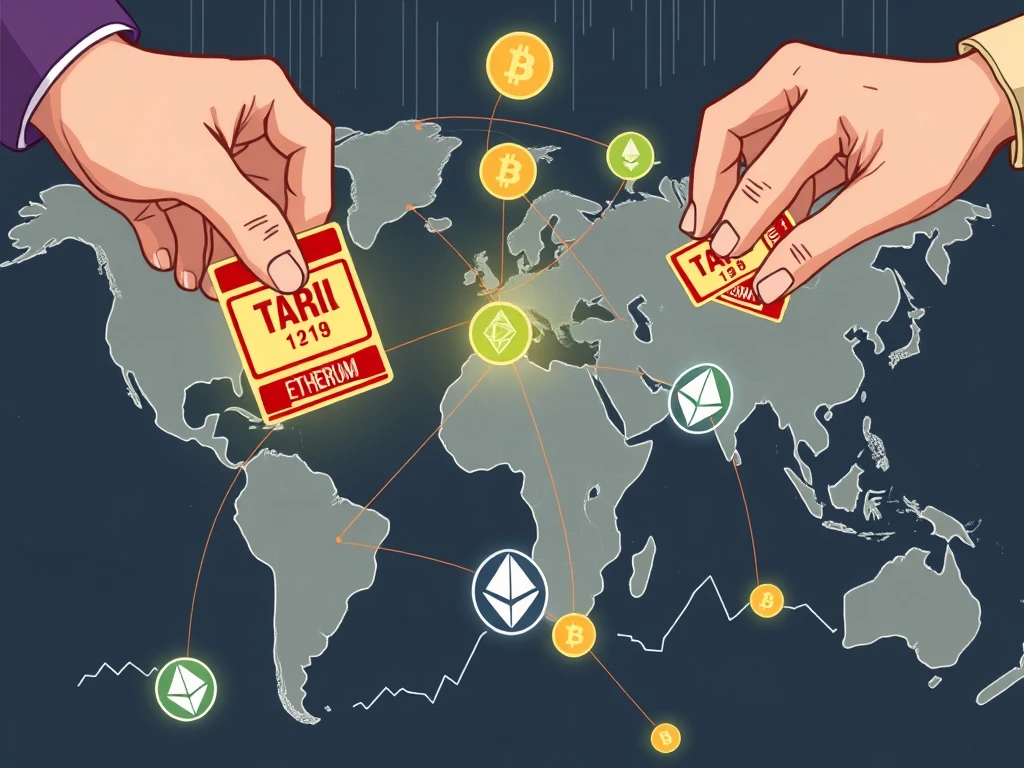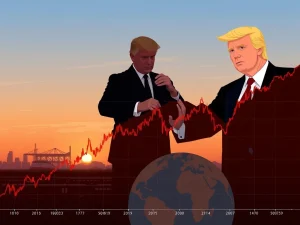Crucial Impact: Reciprocal Tariffs and What They Mean for Crypto

Global trade can feel distant from the fast-paced world of digital assets. Yet, shifts in international policy, like the rise of **reciprocal tariffs**, are having a surprisingly crucial impact on crypto markets. If you’re invested in Bitcoin, Ether, or involved in **bitcoin mining**, understanding these trade dynamics is now essential.
What Exactly Are Reciprocal Tariffs?
Reciprocal tariffs are a trade strategy where one country imposes import taxes on goods from another country, and the second country retaliates by imposing similar taxes on goods from the first. It’s often described as a ‘tit-for-tat’ approach in international trade negotiations.
The concept isn’t new, tracing roots back to policies like the 1930s US Reciprocal Trade Agreements Act, which aimed to reduce barriers. Today, the term often signifies a more confrontational stance.
For instance, in early 2025, the US government imposed tariffs on Chinese imports, citing unfair trade practices and a large trade deficit. These tariffs escalated significantly, reaching up to 145% on some goods. China responded with its own **reciprocal tariffs**, initially 34% on US imports, increasing to 84% and eventually 125%, targeting various American products, particularly agriculture and machinery.
How Do Reciprocal Tariffs Function?
While the core idea is simple retaliation, the specifics of how tariffs are calculated and applied can differ between countries.
How the US Calculates Tariffs
In 2025, the US adopted a formula linking tariff rates to the trade deficit with a specific country. The formula is:
Tariff rate (%) = (US trade deficit with country / US imports from country) × 100 / 2
Using the example from early 2025 with China:
- US imports from China: $438.9 billion
- US exports to China: $147 billion
- Trade deficit: $291.9 billion
- Deficit ratio: ($291.9 billion ÷ $438.9 billion) × 100 ≈ 66.5%
- Calculated Tariff rate: 66.5% ÷ 2 ≈ 33.25%
This led to the US imposing a 34% tariff. Importantly, these new tariffs often stack on top of existing ones. A product with a previous 20% tariff hit with an additional 34% reciprocal tariff suddenly faces a total 54% import tax, making foreign goods much more expensive.
How China Responds
China’s response to US tariffs is often strategic, targeting sectors important to the US economy and voter base rather than strictly following a formula.
Targeted sectors frequently include:
- Agriculture: Products like soybeans, pork, and beef are common targets. A 2018 25% tariff on US soybeans significantly impacted US farmers.
- Aerospace: Actions like suspending imports of Boeing aircraft and parts have affected the US aerospace industry.
Implementation is often phased:
- Following US increases in early 2025, China initially applied a 34% tariff on all US goods, escalating to 84% and 125% as US tariffs rose.
- Additional tariffs (10%-15%) were also placed on specific agricultural goods like corn, soybeans, and wheat.
China’s method prioritizes economic and political pressure over direct rate matching.
Economic Fallout from Reciprocal Tariffs
The effects of reciprocal tariffs extend beyond the directly involved countries, impacting the global economy significantly.
- Global Trade Slows: Organizations like the World Trade Organization (WTO) noted in early 2025 that projected global trade growth slowed dramatically, attributing it to aggressive tariff strategies and resulting retaliations. Reduced exports and imports create widespread uncertainty.
- Developing Countries Suffer: Economies reliant on exporting goods to large markets like the US are hit hard. Higher tariffs mean fewer orders, job losses, and reduced income in vulnerable nations.
- Prices Rise for Consumers: Tariffs on imported goods increase costs for consumers on items from electronics to household staples. Businesses using imported parts also face higher costs, often passed on to customers, contributing to inflation.
The International Monetary Fund projected that the **trade war** could reduce global GDP growth, illustrating the significant economic cost.
The Direct Crypto Impact
Economic instability caused by trade conflicts directly influences financial markets, including cryptocurrencies. The uncertainty generated by reciprocal tariffs often leads to market volatility.
- Market Volatility: When the US announced a 50% tariff on Chinese imports in April 2025, crypto markets reacted sharply. Bitcoin (BTC) price dropped, and Ether (ETH) saw a significant decline. This showed how sensitive crypto is to macroeconomic shifts. A subsequent pause in tariffs led to a quick rebound, highlighting market responsiveness to policy changes.
- Bitcoin Mining Costs Increase: US **bitcoin mining** operations face higher costs due to tariffs on imported equipment. Tariffs up to 36% on essential hardware from countries like China and Taiwan increase capital expenditures. This disproportionately affects smaller miners who struggle to absorb costs or renegotiate deals, potentially forcing some to shut down or relocate to places without these tariff barriers.
- Crypto Investment Trends Shift: Economic uncertainty often drives investors toward assets perceived as safe havens. Crypto is increasingly viewed this way. As traditional markets become volatile due to tariff escalations, investors may turn to Bitcoin and other digital assets as a hedge against inflation or geopolitical risk. Institutional interest is also rising; hedge funds and sovereign wealth vehicles began allocating to digital assets in Q1 2025 partly due to global macro pressures. The reported establishment of a US strategic crypto reserve holding BTC and ETH signals crypto’s growing recognition among traditional finance and policymakers amidst this climate. This shift in **crypto investment** highlights the asset class’s evolving role.
Strategic Steps for Crypto Stakeholders
Given the tangible effects of these policy shifts, those involved in crypto should consider strategic adjustments.
- Diversify Supply Chains: For miners or hardware-dependent businesses, relying on a single country for equipment is risky. Tariffs can quickly erode margins. Sourcing from multiple countries or exploring domestic alternatives can mitigate this risk.
- Monitor the Regulatory Landscape: Crypto companies must stay informed about trade policies, tariffs, and sanctions. These factors influence everything from hardware costs to cross-border payment flows. Legal and trade expertise is becoming crucial.
- Emphasize Crypto’s Unique Narrative: In an era of trade wars and economic fragmentation, crypto’s value proposition as a decentralized, borderless alternative becomes more compelling. Positioning crypto as a hedge against inflation and a tool for financial freedom resonates strongly when traditional systems face disruption. Projects and investors can leverage this narrative to highlight crypto’s resilience.
Conclusion
While seemingly unrelated, reciprocal tariffs and global trade tensions have a direct and significant impact on the crypto industry. From influencing market volatility and increasing **bitcoin mining** expenses to reshaping **crypto investment** strategies, these policy decisions are now a critical factor for stakeholders. Staying informed and adapting strategies is essential for navigating the complexities of a world where trade policy and digital assets are increasingly intertwined.








